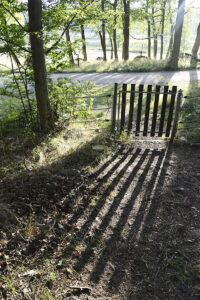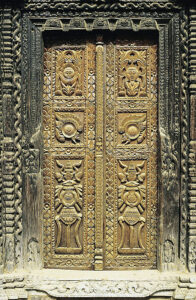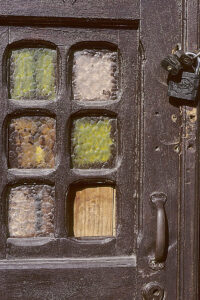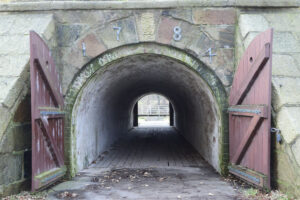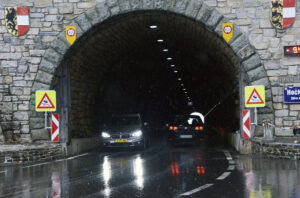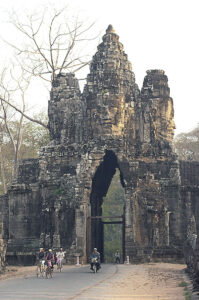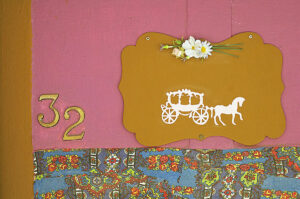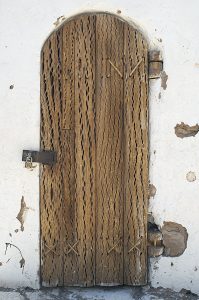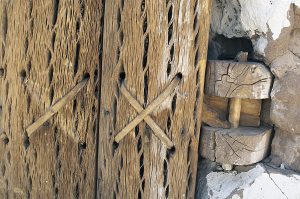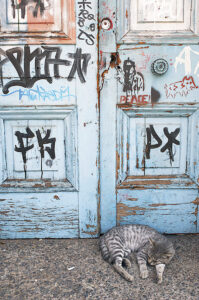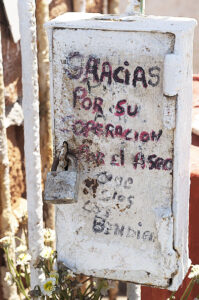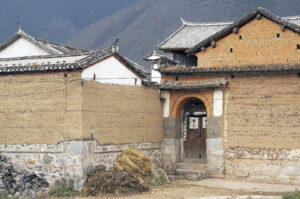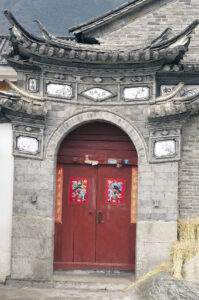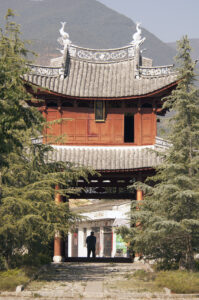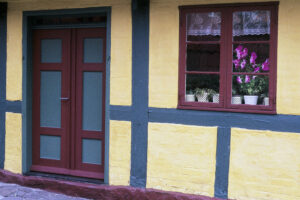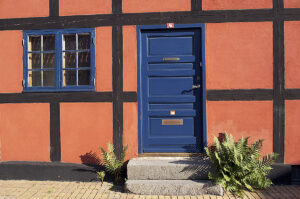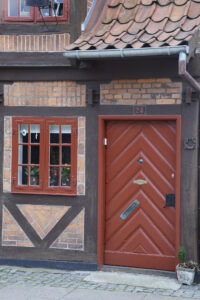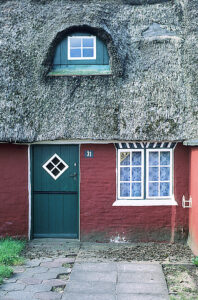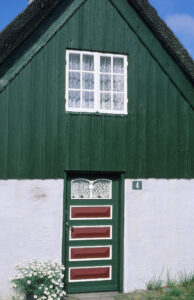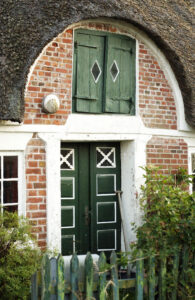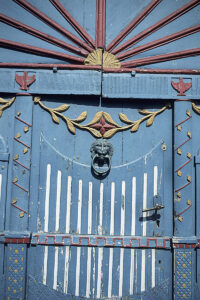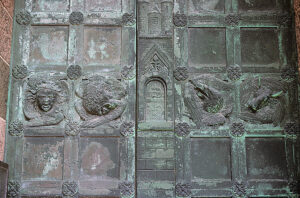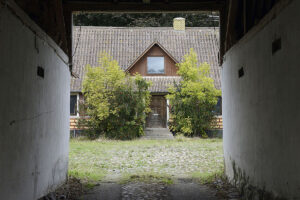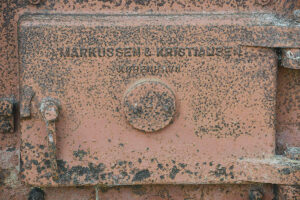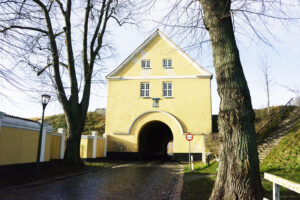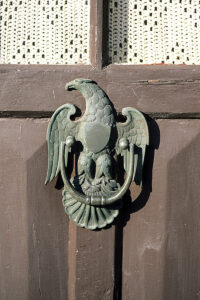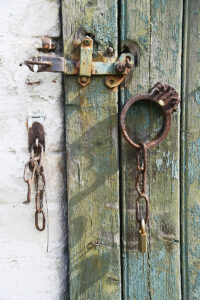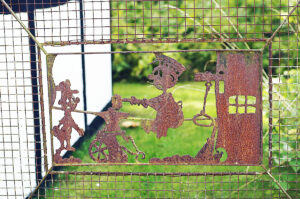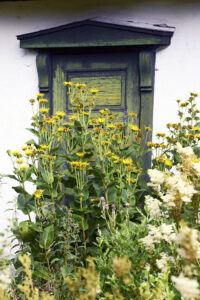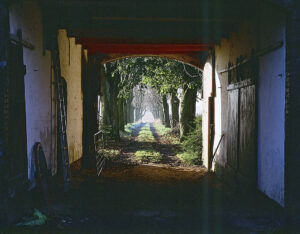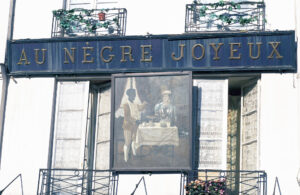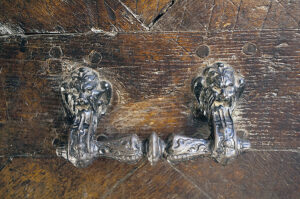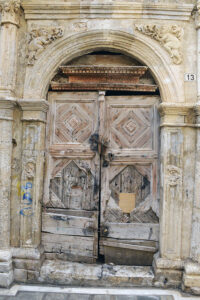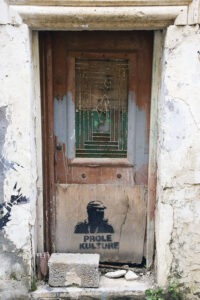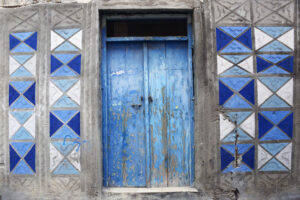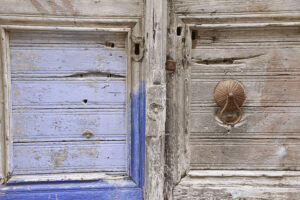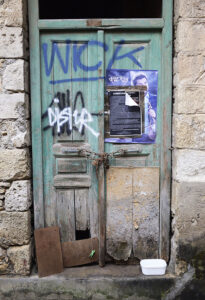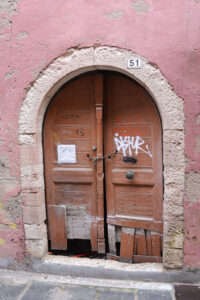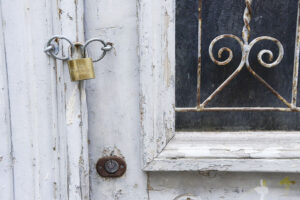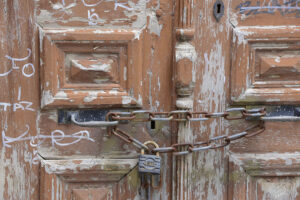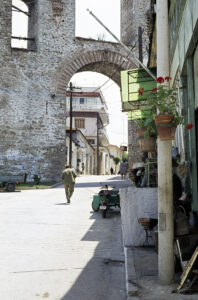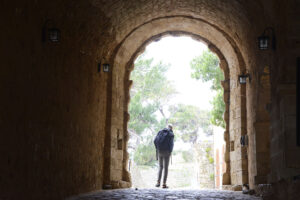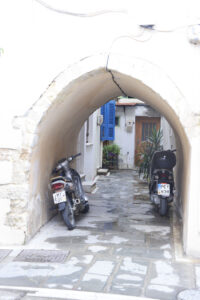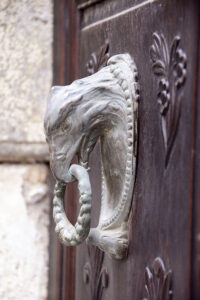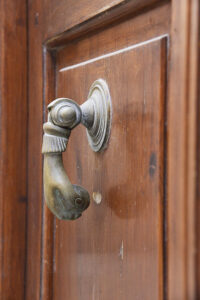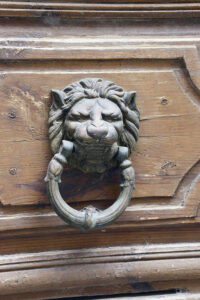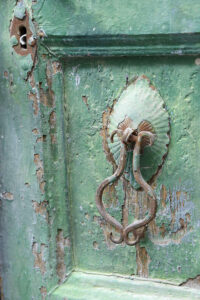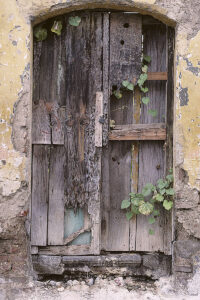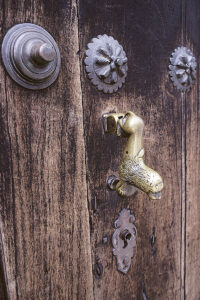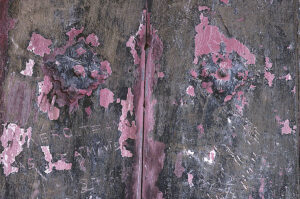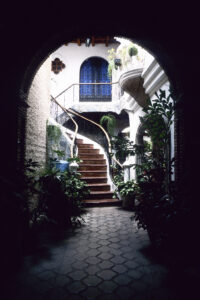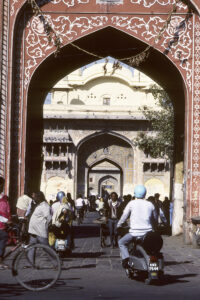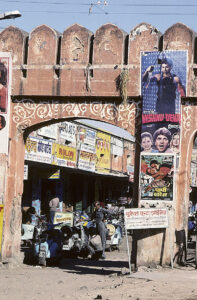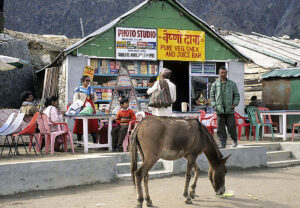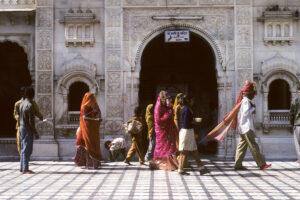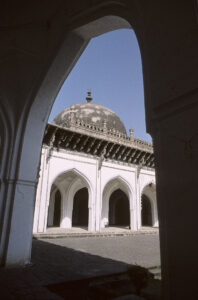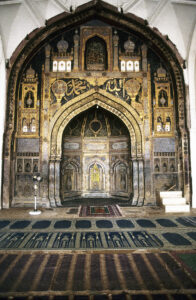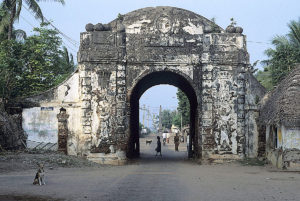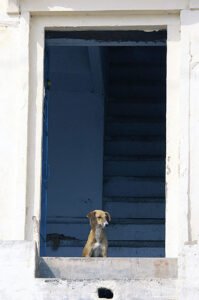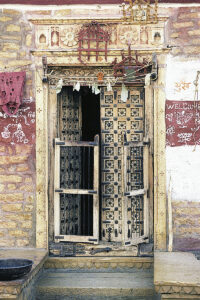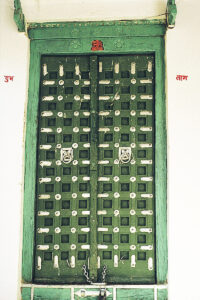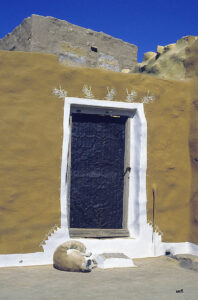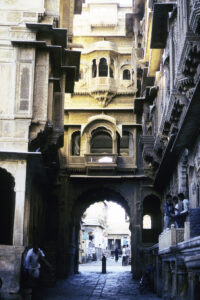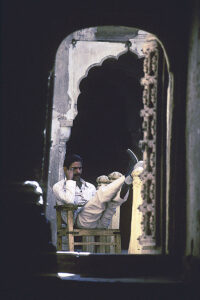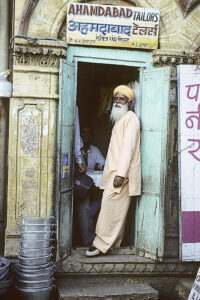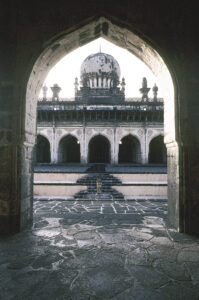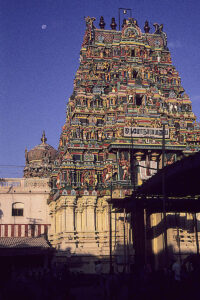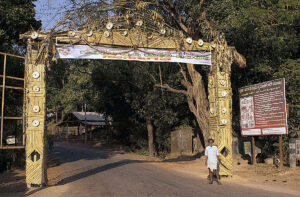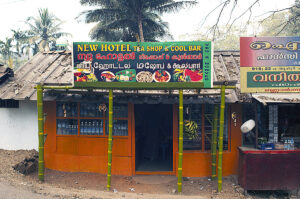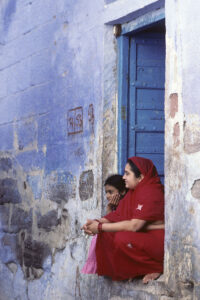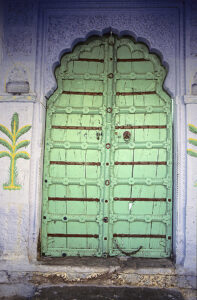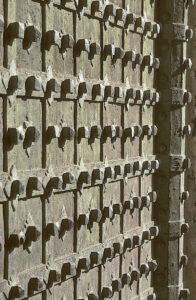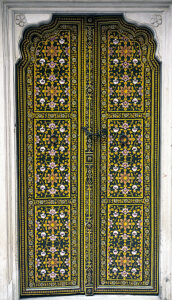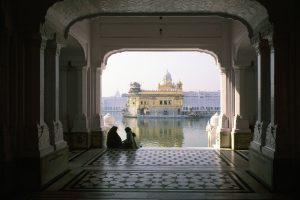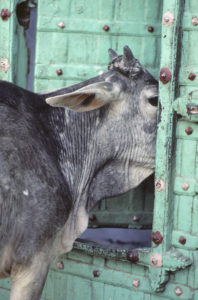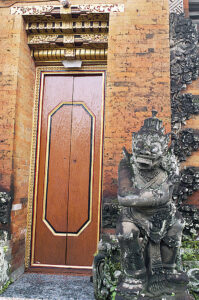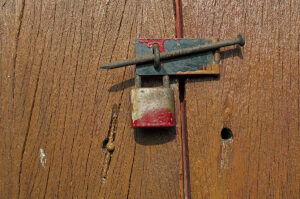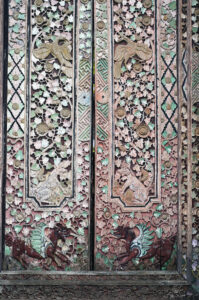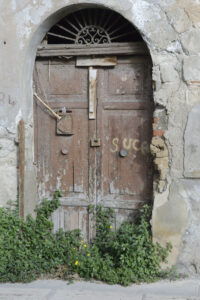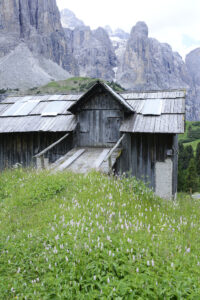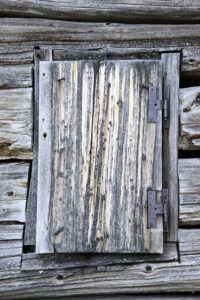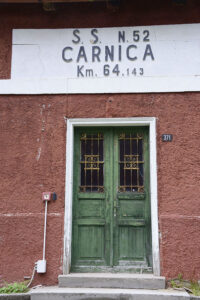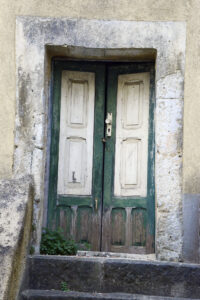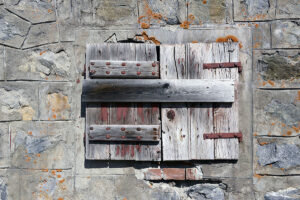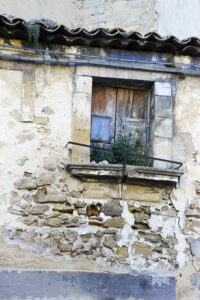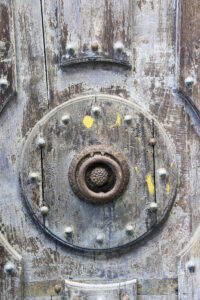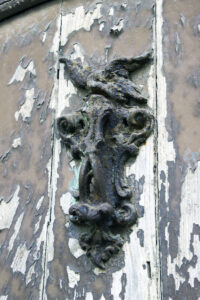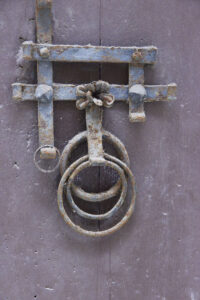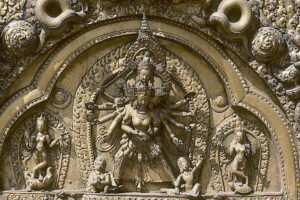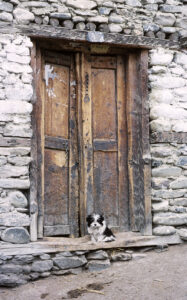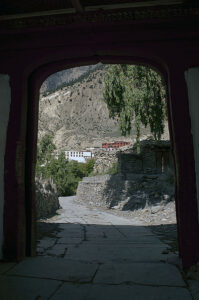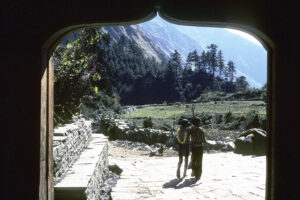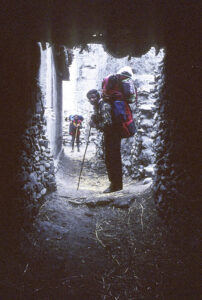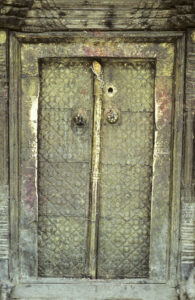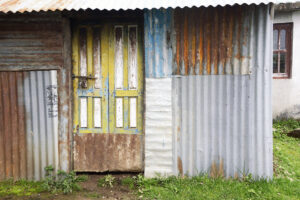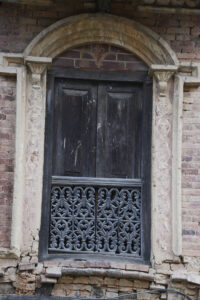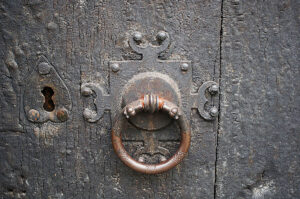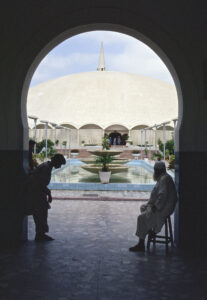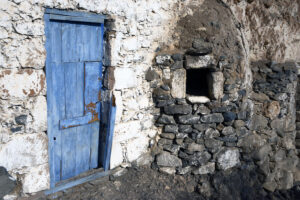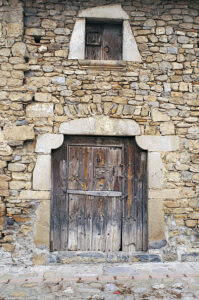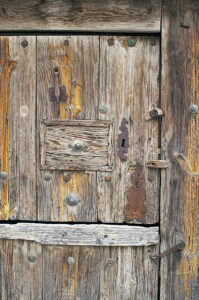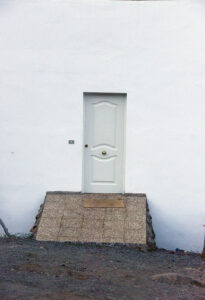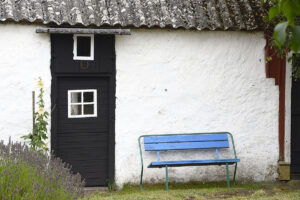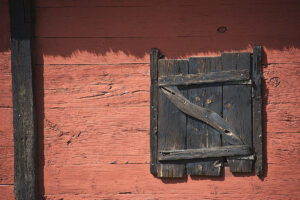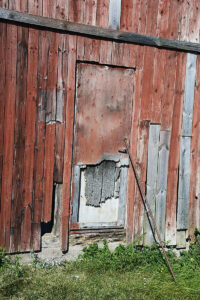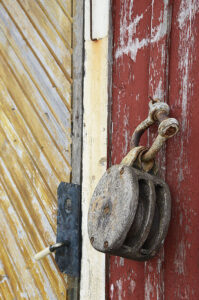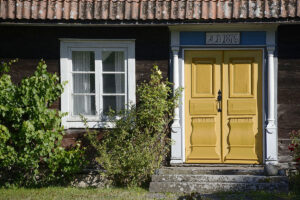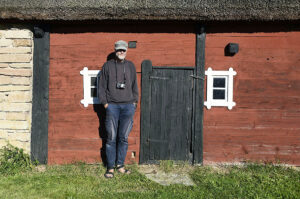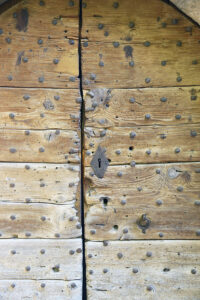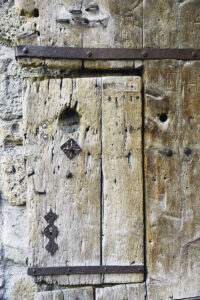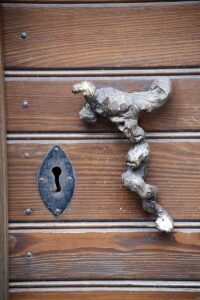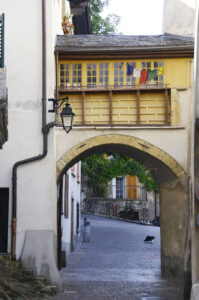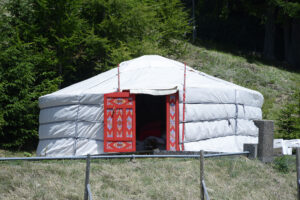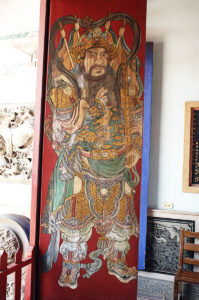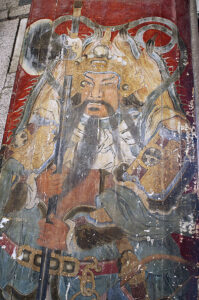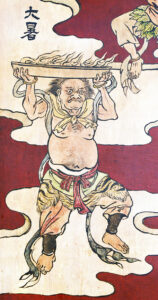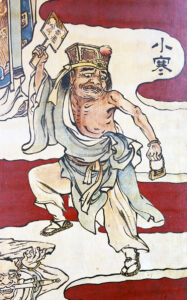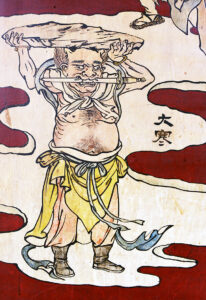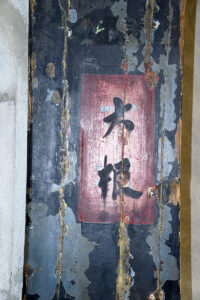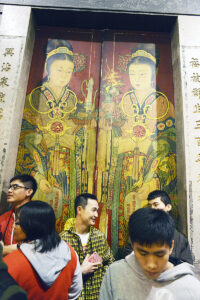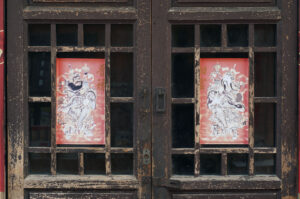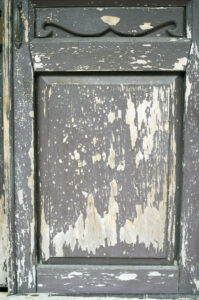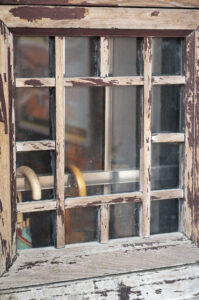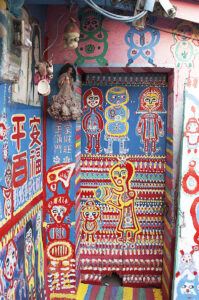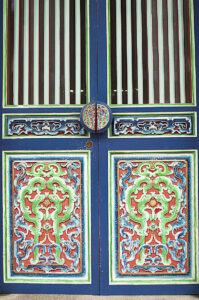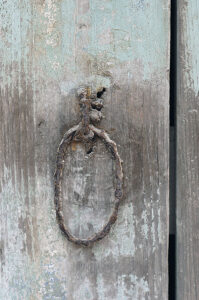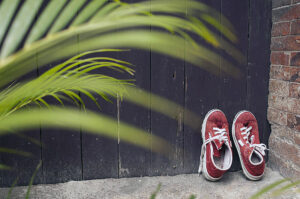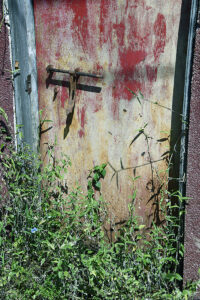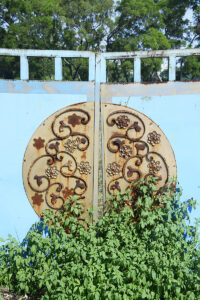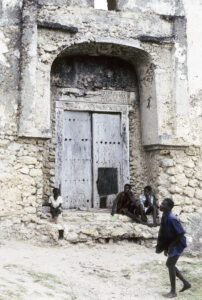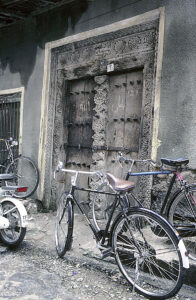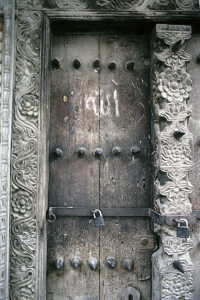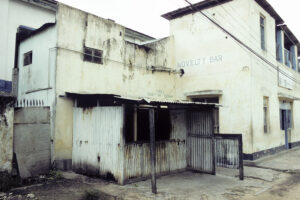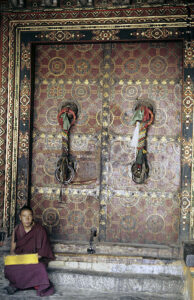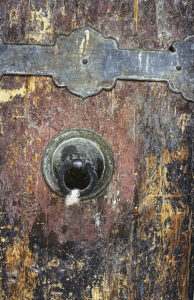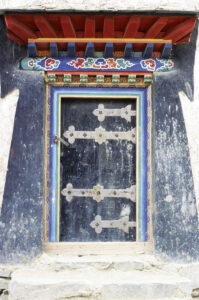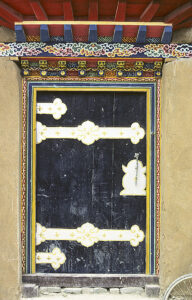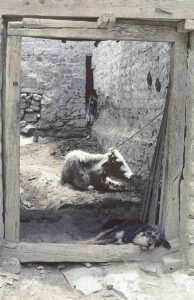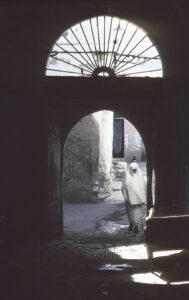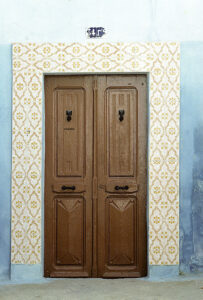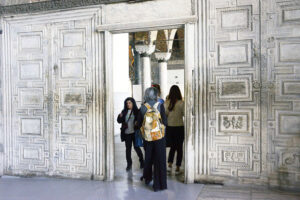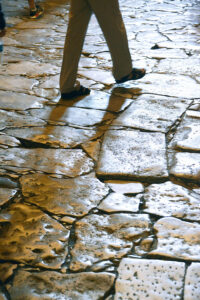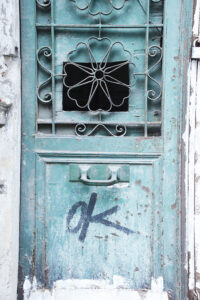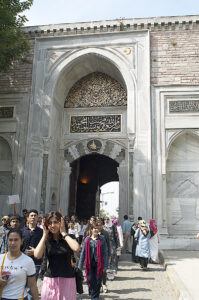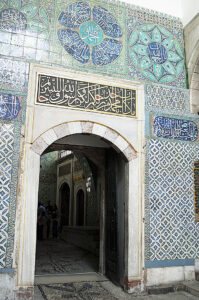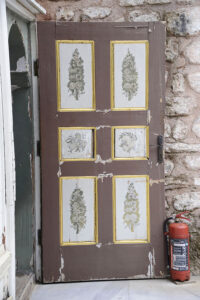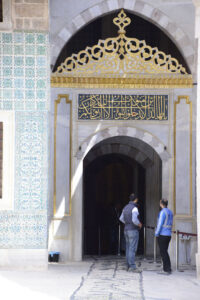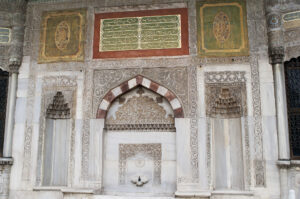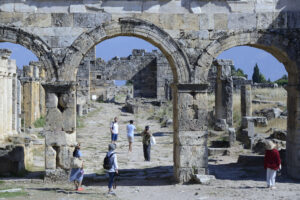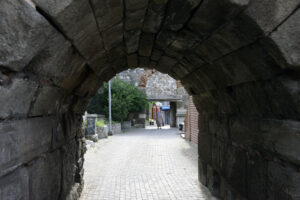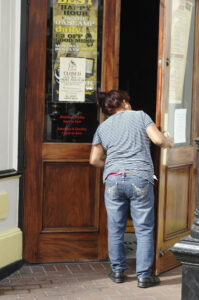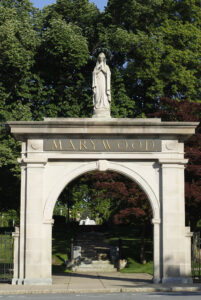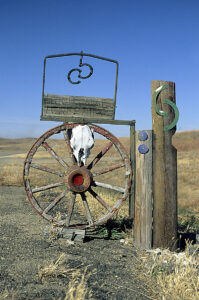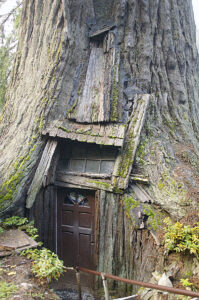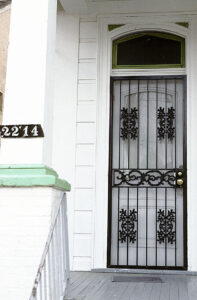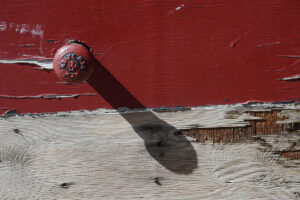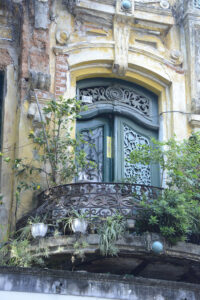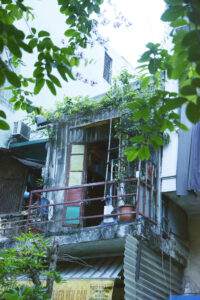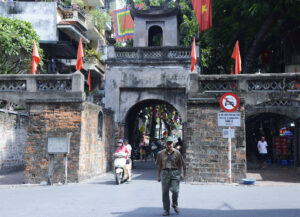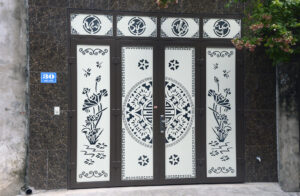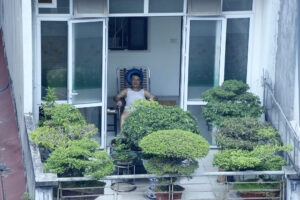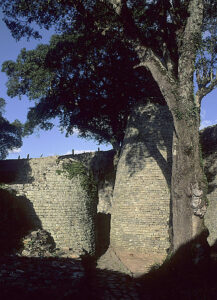Entrances
Gate and late afternoon shadow, Eriksberg Stränder Nature Reserve, Blekinge, Sweden. (Photo copyright © by Kaj Halberg)
Beautifully carved wooden door in the city of Bhaktapur, Kathmandu Valley, Nepal. (Photo copyright © by Kaj Halberg)
Door in Antigua, former capital of Guatemala. (Photo copyright © by Kaj Halberg)
An old entrance gate through the bulwark around Nyborg Castle, Funen, Denmark. The year of completion, 1784, is indicated above the entrance. However, the monogram of King Frederik IV says 1725. (Photo copyright © by Kaj Halberg)
Austria
The tunnel at Hochtor, Grossglockner, is the highest point on the Grossglockner High Alpine Road. This tunnel, 311 m long, was constructed 1933-1935. (Photo copyright © by Kaj Halberg)
Cambodia
A gopura, or gopuram, is an entrance tower, leading into a Hindu temple or temple complex.
Carved faces on the southern gopura, leading into the Hindu Khmer ruins at Angkor Thom. (Photo copyright © by Kaj Halberg)
Chile
Ornate entrance to a private home, Valparaiso. – Other pictures, depicting Valparaiso houses may be seen on the page Culture: A place to live. (Photo copyright © by Kaj Halberg)
This church door in the village of Toconao, San Pedro de Atacama, is made of cactus wood. (Photos copyright © by Kaj Halberg)
Cat, sleeping in front of a door, filled with graffiti, Valparaiso. The long relationship between Man and the cat is described on the page Animals: Animals as servants of Man. (Photo copyright © by Kaj Halberg)
On this entrance gate to a Catholic shrine in Cartagena, dedicated to Virgin Mary, someone has written: “Thank you for participating in keeping this place clean.” – Catholicism is dealt with in detail on the page Religion: Christianity. (Photo copyright © by Kaj Halberg)
China
Entrance gate to a village of the Bai minority, north of Dali, Yunnan Province. (Photo copyright © by Kaj Halberg)
Entrance gate to a Buddhist temple in a Bai minority village, north of Dali, Yunnan Province. (Photo copyright © by Kaj Halberg)
Entrance gate, shaped like a Buddhist pagoda, Xizhou, Yunnan Province. (Photo copyright © by Kaj Halberg)
Denmark
In Scandinavia, during the Middle Ages, houses were built of the durable oak wood, and construction of a single house required felling of several large trees. This practice soon exhausted the supply of trees, and instead people began building the so-called half-timber houses, whose walls consisted of a frame of oak planks, the space between them being filled out with clay bricks.
On the island of Bornholm, many half-timber houses have been preserved, as these in the towns of Gudhjem (top) and Rønne. (Photos copyright © by Kaj Halberg)
Door in a half-timber house, Nyborg, Funen. Note the slanting letter slot. (Photo copyright © by Kaj Halberg)
Typical local houses, with straw roof and bay, in the village of Sønderho, on the island of Fanø, Jutland. (Photos copyright © by Kaj Halberg)
Two entrance gates, leading into the cathedral in the town of Ribe, Jutland. The bronze reliefs in the lower picture depict symbols of the four Christian evangelists: Matthew (winged man), Mark (winged lion), John (eagle), and Luke (winged ox). These evangelists are presented in detail on the page Religion: Christianity. (Photos copyright © by Kaj Halberg)
Entrance to a farm on the island of Langeland. (Photo copyright © by Kaj Halberg)
Door in an oven, formerly used for lime production, Boesdal Kalkbrud, Stevns, Zealand. (Photo copyright © by Kaj Halberg)
Landporten (‘The Country Gate’) in Nyborg, Funen, 40 m long, is the eldest preserved barrel-shaped entrance gate in Denmark. Initially, construction of the gate began during the reign of King Christian III (ruled 1534-1559), and was enlarged during the reign of King Frederik III (ruled 1648-1670). Originally, it was rectangular, forming part of a rampart. The roofed building was added in 1750. Until the 1840s, this was the only entrance to the city. (Photo copyright © by Kaj Halberg)
In the old days, instead of bells, doors were usually equipped with a so-called door knocker, which were often imaginative and fanciful creations.
Eagle, Gudhjem, Bornholm. (Photo copyright © by Kaj Halberg)
I found these old-fashioned doors on an abandoned farm in Zealand. Handle and key hole in the farmhouse (top), and a stable door with rusted chains and an old bicycle lock. (Photos copyright © by Kaj Halberg)
Rusted cast-iron entrance gate, depicting a blacksmith, Vemmetofte, Zealand. (Photo copyright © by Kaj Halberg)
This door in a former laboratory building in Nature Reserve Vorsø, Jutland, has been blocked by a dense growth of elecampane (Inula helenium), meadow sweet (Filipendula ulmaria), creeping thistle (Cirsium arvense), and common nettle (Urtica dioica). (Photo copyright © by Kaj Halberg)
An avenue, consisting of horsechestnut trees (Aesculus hippocastanum) and sycamore maples (Acer pseudoplatanus), leads up to the entrance gate of a farm near Horsens. – Horsechestnut is described on the page Plants: Ancient and huge trees, sycamore maple on the page Nature: Invasive species. (Photo copyright © by Kaj Halberg)
Egypt
Sherif Baha el-Din is a renowned Egyptian herpetologist, who has described several new species of reptiles in Egypt, including the Mount Sinai gecko (Hemidactylus mindiae) and the Qattara gecko (Tarentola mindiae). (His wife’s name is Mindy!)
Sherif Baha el-Din (left) and Danish biologist Uffe Gjøl Sørensen, standing in front of a fancy welcome gate in the Zaranik Protected Area, Sinai, 1999. At this time, Baha el-Din was working with the threatened Egyptian tortoise (Testudo kleinmanni). (Photo copyright © by Kaj Halberg)
France
Au Nègre Joyeux (‘The Merry Negro’), Rue Mouffetard, Paris, was a store selling coffees, chocolates, and confectionery. It was founded in 1812 and existed for more than a hundred years. Today, the building is a convenience store.
Until 2018, the old sign and an oil painting were still hanging on the building. The painting was first interpreted as a racist image, depicting a woman, served by a black servant. However, the exact opposite is the case: a happy black man, dressed as an 18th Century gentleman, has just risen to toast, and is served by a white maid, wearing the usual attire of servants in the 19th Century.
Following several cases of vandalism, the painting was removed in 2018, and is now kept at the Musée Carnavalet.
Au Nègre Joyeux, Rue Mouffetard, Paris, photographed in 2007. Note that the plexiglass cover on the painting has been broken by vandals. (Photo copyright © by Kaj Halberg)
Entrance to a bar, Latin Quarter, Paris. (Photo copyright © by Kaj Halberg)
Door handle with two faces, sticking out their tongue, Latin Quarter, Paris. (Photo copyright © by Kaj Halberg)
Greece
Below, a selection of pictures shows more or less dilapidated doors in the city of Rethymno, Crete.
(Photos copyright © by Kaj Halberg)
Entrance through an old Roman aqueduct, Kavala. (Photo copyright © by Kaj Halberg)
Entrance to the old fort, Rethymno, Crete. (Photo copyright © by Kaj Halberg)
Entrance to a courtyard, Rethymno, Crete. (Photo copyright © by Kaj Halberg)
In the old days, instead of bells, doors were usually equipped with a so-called door knocker. Below, a selection of these often imaginative or fanciful creations is shown, likewise from Rethymno.
Eagle. (Photo copyright © by Kaj Halberg)
Fist. (Photo copyright © by Kaj Halberg)
Lion’s heads. (Photos copyright © by Kaj Halberg)
Once upon a time, this door handle also functioned as a door knocker. (Photo copyright © by Kaj Halberg)
Guatemala
Antigua, the former capital of Guatemala, is a gorgeous old Spanish colonial town, with cobbled streets, pastel-colored houses, arches across the streets, and a huge number of spectacular churches. This attractive city is described in detail on the page Travel episodes – Guatemala 1998: Country of the Mayans.
A collection of doors in Antigua. (Photos copyright © by Kaj Halberg)
Courtyard, Antigua. (Photo copyright © by Kaj Halberg)
India
The city of Jaipur, Rajasthan, was founded in 1726 by Jai Singh II, who was the Maharaja of Amer, a mountain town c. 10 km from present-day Jaipur. Amer was facing a problem of increasing scarcity of water, and the Maharaja decided to move his capital to the nearby plains.
The Old Town of Jaipur has been dubbed The Pink City, as many of its houses are painted pink. This tradition goes back to 1876, when Queen Victoria and the Prince of Wales visited the city. As pink denotes the colour of hospitality in India, the Maharaja decided to have the entire city painted pink, as a sign of welcome to his royal guests.
Two entrance gates in the city wall, surrounding Jaipur. The posters on the wall advertise typical Hindi movies. (Photos copyright © by Kaj Halberg)
In spring and autumn, the Rohtang La Pass, Himachal Pradesh, is a very popular destination for Indian tourists, and below the pass, numerous dhabas (small road-side restaurants) have sprung up helter-skelter. Weather permitting, most guests prefer to sit outside the restaurants, as the interior is often damp and dark.
This dhaba below the Rohtang La Pass offers juice and ‘snex’. Despite the cold, the guests are sitting outside the restaurant, as the entrance leads into a dark hole. (Photo copyright © by Kaj Halberg)
In Deshnok, Rajasthan, a local goddess, Karna Mata, is regarded as an incarnation of Devi. Her followers believe that if you are reborn as a rat, you escape the wrath of Yama, ruler of the underworld and the god of judgement after death. For this reason, rats are sacred.
The entrance to the Hindu temple of Karna Mata Mandir, Deshnok. (Photo copyright © by Kaj Halberg)
The mosque Jama Masjid in Bijapur, Karnataka, was initiated in 1576 by Ali Adil Shah I of the Bijapur Sultanate, but was never completed. Holding a capacity of 4,000 worshippers, it is the largest mosque in Bijapur.
Jama Masjid, Bijapur. (Photos copyright © by Kaj Halberg)
In November 1618, the Danish King Christian IV ordered one of his admirals, Ove Giedde, to be the commander of a fleet of five ships, bound for India. The aim of this journey was to establish a trading station under the Royal Danish East India Company, to be able to bring cheap spices and textiles to the Motherland.
Two years later, Giedde and his crew reached the Coromandel Coast, at the mouth of River Kaveri in present-day Tamil Nadu, South India. Following negotiations with the Prince of Thanjavur, Giedde obtained permission to build a trading station, which was called Trankebar (in English Tranquebar) – a corruption of the local Tamil name of the place, Tarangambadi, which means ‘singing waves’. In 1660, a fort was completed, named Dansborg (’Danish Castle’). Behind this fort, a town sprang up, fortified with moats and walls, through which a number of gates gave access to the town.
This picture shows the most striking of the town gates of Tranquebar, named Landporten (‘The Country Gate’), as of year 2000. It has since been restored. (Photo copyright © by Kaj Halberg)
The Indian Paria dog and many other members of the dog family are described on the page Animals – Mammals: Dog family. This Paria dog is scanning its surroundings from a doorway in the city of Varanasi. (Photo copyright © by Kaj Halberg)
During the era of the great trading caravans, a side branch of the Old Silk Road led through the city of Jaisalmer, in the Thar Desert, Rajasthan. Travelling along this route, numerous camel caravans brought goods to and from India, trading with faraway China, Persia, Turkey, and Europe. As wealth accumulated in Jaisalmer, rich traders built extravagant and ornate sandstone mansions, called havelis, their walls and balconies decorated with beautiful and detailed carvings.
The Thar Desert and Jaisalmer are presented in depth on the page Travel episodes – India 2003: Camel safari in the Thar Desert.
A collection of doors in Jaisalmer. (Photos copyright © by Kaj Halberg)
Entrance gate beneath a haveli, a richly ornamented house, carved in yellow sandstone, Jaisalmer. (Photo copyright © by Kaj Halberg)
Relaxed reading position in a door-way, Jaisalmer. (Photo copyright © by Kaj Halberg)
A tiny tailor’s workshop, Jaisalmer. (Photo copyright © by Kaj Halberg)
Entrance to the Ibrahim Mouza Mosque, Bijapur, Karnataka. (Photo copyright © by Kaj Halberg)
A gopura, or gopuram, is an entrance tower, leading into a Hindu temple or temple complex. The pictures below show a gopura in the Minakshi Temple, Madurai, Tamil Nadu, which is adorned with thousands of sculptures. This temple is dedicated to goddess Minakshi, a South Indian name for Shiva’s shakti, or female energy, who, in northern India, is called Devi, Uma, or Parvati. The concept of shakti, and other Hindu phenomena, are described in detail on the page Religion: Hinduism.
The lower picture shows a detail of the gopura, depicting a scene from the epic Hindu drama The Churning of the Milk Ocean, from the Bhagavata-Purana. This drama is also related on the page Religion: Hinduism.
(Photos copyright © by Kaj Halberg)
Many entrances to Indian villages are adorned with welcome gates.
This welcome gate, constructed of bamboo, which adorns the entrance to a village in the Honnavar Forest, Karnataka, is illuminated by late afternoon sunshine. (Photo copyright © by Kaj Halberg)
This roadside restaurant in Mukkali, Kerala, is adorned with a welcome gate, made from bamboo poles. The language on the signs is Malayalam. (Photo copyright © by Kaj Halberg)
Between 600 and 1500 A.D., Rajasthan – in those days called Rajputana – was divided among numerous rivalling Hindu kingdoms, ruled by Rajputs (‘Sons of Rajas’). These people were born warriors, divided into 36 royal clans. Because of their internal rivalries, each Rajput king ordered his people to build forts and other strongholds to protect himself and his nobles against enemies. Naturally, nobody worried about the safety of the common people.
The city of Jodhpur, Rajasthan, was founded in 1459 by Rajput Prince Rao Jodha. The Old Town is aptly called ‘The Blue City’, as most of its houses are painted a light blue. Originally, these blue houses were inhabited by Brahmins, and their colour indicated that here you could ask advice about disease as well as religious issues. Furthermore, the blue paint contains copper oxides, which keep termites at bay. Around 1460, Rao Jodha also ordered the imposing Mehrangarh Fort built on a hill top, 125 m above the city.
Blue house in Jodhpur. (Photo copyright © by Kaj Halberg)
Door in a blue house, Jodhpur. (Photo copyright © by Kaj Halberg)
One of the six armoured ancient entrance gates, leading into the Mehrangarh Fort, Jodhpur. (Photo copyright © by Kaj Halberg)
Ornate door in a Rajput fort in Bikaner, Rajasthan, built in the 1400s. (Photo copyright © by Kaj Halberg)
The most important Sikh temple is Hari Mandir, in the city of Amritsar, Punjab. This shrine, dubbed ’The Golden Temple’, is built around a sacred pond, Amrit Sarovar, which gave name to the city. This gorgeous building is described in depth on the page Travel episodes – India 1997: Golden Temple of the Sikhs. (Photo copyright © by Kaj Halberg)
Do you have any goodies for me? – Inquisitive zebu, looking into a doorway, Jodhpur, Rajasthan. This ox is described on the page Animals: Animals as servants of Man. (Photo copyright © by Kaj Halberg)
Indonesia
This temple guardian in front of the entrance to a Hindu temple near Ubud, Bali, keeps evil forces at bay. – Temples and other aspects of Hinduism are dealt with in detail on the page Religion: Hinduism. (Photo copyright © by Kaj Halberg)
It seems that the padlock on this door, leading into another Hindu temple near Ubud, is no longer necessary. (Photo copyright © by Kaj Halberg)
Door in a house, decorated with carvings of plants, birds, and lions, Ubud. (Photo copyright © by Kaj Halberg)
Ireland
Warning, scribbled on a door in Dublin. (Photo copyright © by Kaj Halberg)
Italy
Dilapidated door, Castellamare del Golfo, Sicily. The plants are slender sowthistle (Sonchus tenerrimus) and spreading pellitory-of-the-wall (Parietaria judaica). (Photo copyright © by Kaj Halberg)
Elevated entrance to a hay barn, Passo Gardena, Dolomites. The plant in the foreground is common bistort (Bistorta officinalis). (Photo copyright © by Kaj Halberg)
Hayloft door, Passo Gardena. (Photo copyright © by Kaj Halberg)
Door in an abandoned building, Passo della Mauria, Dolomites. (Photo copyright © by Kaj Halberg)
Dilapidated door, Mineo, Sicily. (Photo copyright © by Kaj Halberg)
Hatch in the former customs building, Little Saint Bernhard Pass, on the border between Italy and France. (Photo copyright © by Kaj Halberg)
Dilapidated balcony door with growth of slender sowthistle (Sonchus tenerrimus), Mineo, Sicily. (Photo copyright © by Kaj Halberg)
Dilapidated doors with remains of door knockers, Cefalú, Sicily. (Photos copyright © by Kaj Halberg)
Kyrgyzstan
Door in the city of Karakol, advertising Coca Cola. (Photo copyright © by Kaj Halberg)
Nepal
In Hindu temples in the Kathmandu Valley, a so-called toran is placed above almost all doors and windows. A toran is a gilded, semi-circular brass or copper plate, often depicting Hindu deities. It corresponds to the tympanum in Greek and Roman temples, and in Christian churches.
The toran in the picture below, situated above the Sun Dhoka (‘Golden Gate’) in the Royal Palace, Bhaktapur, depicts the 4-headed and 16-armed Hindu goddess Taleju, protector of the former Malla Kings of the Kathmandu Valley, who ruled from about 1200 to 1768. Traditionally, the kings of Kathmandu were regarded as incarnations of the god Vishnu, and to the left, beneath the goddess, is a depiction of Garuda, the man-eagle mount of Vishnu..
Hindu gods and other aspects of Hinduism are dealt with in detail on the page Religion: Hinduism.
(Photo copyright © by Kaj Halberg)
This tiny dog is guarding a house in the village of Braga, Upper Marsyangdi Valley, Annapurna. (Photo copyright © by Kaj Halberg)
At the entrance to many villages in Nepal, welcome gates have been constructed, spanning the road or trail, leading to the village. Two examples from the Kali Gandaki Valley, Annapurna, are shown below.
Welcome gate at the village of Marpha. (Photo copyright © by Kaj Halberg)
Welcome gate at the village of Ghasa. One of the children is wearing a garland of marigolds, a so-called malla, around the neck. Such garlands are often worn during Hindu festivals. (Photo copyright © by Kaj Halberg)
Entrance to the village of Kagbeni, Kali Gandaki Valley, Mustang. (Photo copyright © by Kaj Halberg)
Brass door in a Hindu temple, Kirtipur, Kathmandu Valley. (Photo copyright © by Kaj Halberg)
This entrance to a shed in the village of Chipling, Helambu, was probably quite fancy in bygone days. (Photo copyright © by Kaj Halberg)
Door in a dilapidated house, Dhulikhel. (Photo copyright © by Kaj Halberg)
Norway
Lom Stavkirke, a stave church in the Gudbrand Valley, is one of the largest stave churches in Norway. It was probably erected during the 1100s. This picture shows a detail of one of its doors. (Photo copyright © by Kaj Halberg)
Pakistan
Masjid-e-Tooba (‘The Round Mosque’) in Karachi, also known as Gol Masjid, was constructed 1966-1969. With a total area of 4,657m², it is probably the largest single-dome mosque in the world, having no pillars in the central prayer hall, the huge dome being supported on a low surrounding wall. During prayer, the mosque may hold up to 5,000 people.
Entrance to Masjid-e-Tooba, Karachi. (Photo copyright © by Kaj Halberg)
Spain
Pre-Spanish cave near Vega de Acusa, Gran Canaria. Originally, it was inhabited by the indigenous people of the islands, the Guanches, a Berber people who migrated to the islands from Morocco. Later, the cave was used by Spanish herders, who put a door in the opening. (Photo copyright © by Kaj Halberg)
Old-fashioned house door in the village of Binies, Aragon. (Photos copyright © by Kaj Halberg)
Door with an unusual way up, Veneguera, Gran Canaria. (Foto copyright © by Kaj Halberg)
Sweden
Village scene, Hulterstad, Öland, with a black-and-white door, a blue bench, common hollyhock (Alcea rosea), and common lavender (Lavandula angustifolia). (Photo copyright © by Kaj Halberg)
Old-fashioned hatch in a preserved farm house, Himmelsberga Museum, Öland. (Photo copyright © by Kaj Halberg)
Door in a dilapidated barn, Öland. (Photo copyright © by Kaj Halberg)
Door and tackle in an old fisherman’s shed, Gräsgård Harbour, Öland. (Photo copyright © by Kaj Halberg)
Main entrance to a farm house, Gillsätra, Öland. (Photo copyright © by Kaj Halberg)
People were indeed small in the old days, evident from this picture of a door in an old farm house in the village of Föra, Öland. (Photo copyright © by Kaj Halberg)
Switzerland
Old wooden doors in the castle Chateau Valère, Sion, Valais. Originally, this castle was a fortified basilica, founded in the early 1100s. (Photos copyright © by Kaj Halberg)
This door handle in the village of Plan Cerisier, Rhone Valley, has been made from a branch of a grape vine plant. (Photo copyright © by Kaj Halberg)
Entrance tunnel to a street in Sion, Valais. (Photo copyright © by Kaj Halberg)
This Mongolian-type yurt, called a ger, was exhibited at Col de la Forclaz, Valais. (Photo copyright © by Kaj Halberg)
Taiwan
Almost all entrance doors to Taiwanese Daoist temples are adorned with paintings, often depicting various guardians, who protect the temple against evil forces. The following 7 pictures show such doors.
Daoism is described in detail on the page Religion: Daoism in Taiwan.
Guardians on doors in Tien Hou Gong (‘Heavenly Empress Palace’), a temple for the Mother Goddess Mazu, Lugang. (Photos copyright © by Kaj Halberg)
These three pictures from a door in a Mazu temple in Beigang illustrate various seasons: ‘severe heat’, i.e. height of the summer (top), ‘little heat’, i.e. autumn (centre), and ‘severe cold’, i.e. height of the winter. (Photos copyright © by Kaj Halberg)
Door in a temple, Shingang. (Photo copyright © by Kaj Halberg)
Dilapidated door in Gong Fan, a Daoist temple in the town of Mailiao. (Photo copyright © by Kaj Halberg)
Only once a year, about two hours before midnight on Chinese New Year’s Eve, entrances to Daoist temples are closed. They will be re-opened at midnight, marking the start of the new year. – This picture was taken on New Year’s Eve in the Fushing Temple, dedicated to the Mother Goddess Mazu, in the town of Xiluo. (Photo copyright © by Kaj Halberg)
Dilapidated doors, Lugang. (Photos copyright © by Kaj Halberg)
In a suburban area of Taichung, a retired soldier has decorated houses, walls, and streets with colourful paintings, and, for this reason, the area has been dubbed Tsai Hung Tsun (‘Rainbow Village’).
Other pictures, depicting this art work, are presented on the page Culture: Folk art of Taiwan.
(Photo copyright © by Kaj Halberg)
Old-fashioned doors in the town of Lugang, western Taiwan. (Photos copyright © by Kaj Halberg)
Sneakers, drying outside a door in Lugang. (Photo copyright © by Kaj Halberg)
This roller shutter in a kindergarten in Taichung is decorated with a painting of Snow White and the seven dwarves. (Photo copyright © by Kaj Halberg)
Obviously, these doors in Taichung are no longer in use, as various weeds have grown up in front of them. The upper picture shows Asiatic dayflower (Commelina communis) with blue flowers and oblong leaves, and the plant in the lower picture is downy bur-marigold (Bidens pilosa). Both species are described on the page Plants: Urban plant life. (Photos copyright © by Kaj Halberg)
Rusted flower ornamentation on an entrance gate to a private home, Taichung. (Photo copyright © by Kaj Halberg)
Tanzania
Gereza is an Arabian fort in the town of Kilwa Kisiwani, on the Tanzanian coast, built on the order of the Sultan of Muscat around 1800.
Our at times rather grotesque adventures along this coast are described on the page Travel episodes – Tanzania 1988: Experiencing African bureaucracy.
Entrance gate to the Gereza Fort. (Photo copyright © by Kaj Halberg)
Old wooden door, Zanzibar Town. (Photos copyright © by Kaj Halberg)
Novelty Bar, Lindi – maybe not so new any more? (Photo copyright © by Kaj Halberg)
Tibet
My at times rather grotesque adventures in Tibet are related on the page Travel episodes – Tibet 1987: Tibetan summer.
In 1965, when the Chinese leader Mao Tse-dung invented the term ‘Cultural Revolution’, religious practices were forbidden, and a mass destruction of cultural treasures began in all Chinese territories. Religious paintings were destroyed and icons smashed, and Buddhist monasteries were torn down by gangs of ravaging Red Guards. In Lhasa, the capital of Tibet, the monks were driven out of Jokhang, the largest religious sanctuary in Tibet, and the marvellous building became a pig-pen.
Following the death of Chairman Mao in 1976, and the arrest of the so-called ‘Gang of Four’, conditions changed. The Cultural Revolution came to a halt, restrictions on religious practice were somewhat eased, and Jokhang was re-opened.
Tibetan Buddhism is described on the page Religion: Buddhism.
Entrance to the Jokhang Temple in Lhasa. (Photo copyright © by Kaj Halberg)
Old-fashioned handle on a worn wooden door, Sera Buddhist monastery, Lhasa. Note the tuft of sheep’s wool, which has been tied to the ring, maybe to make it less sharp. (Photo copyright © by Kaj Halberg)
During the summer 1987, I stayed a couple of weeks in the town of Shigatse. At that time, Chinese authorities had already begun levelling large areas of the town to create a ‘modern’ (i.e. communist concrete style) town. In 2004, when I again paid a visit to Shigatse, very little of the old quarters remained.
Doors in traditional Tibetan houses, Shigatse. (Photos copyright © by Kaj Halberg)
A dog and a cow are resting at the entrance door to a traditional Tibetan house in Shigatse. In former days, you would often enter a courtyard before arriving at the living quarters. (Photo copyright © by Kaj Halberg)
Would you visit this ‘restaorant’ in Tingri, even if you were very hungry? (Photo copyright © by Kaj Halberg)
Tunisia
Originally, a medina, in Arabic al-madinah al-qadimah (‘old city’), was a distinct city section in North African cities, and in Malta. A typical medina is surrounded by a wall and has many narrow, maze-like streets.
Gateway in the medina of Sousse. (Photo copyright © by Kaj Halberg)
Doors in private houses, Sousse. In the lower picture, mussel shells have been used as decoration in the wall. (Photos copyright © by Kaj Halberg)
Turkey
One of Christendom’s most gorgeous buildings is the Byzantine Church of the Holy Wisdom, in Istanbul, usually called Hagia Sophia, or, in Turkish, Aya Sofia. This grand structure, which was erected 532-537 during the reign of Roman Emperor Justinian, was converted into a mosque in 1453, and today it is a museum.
Other pictures from this marvellous building may be seen at Religion: Christianity.
Carved marble door from the 6th Century, Aya Sofia. (Photo copyright © by Kaj Halberg)
A rather steep and gloomy ascent leads up to the upper gallery in Aya Sofia. The stones have been worn smooth by the steps of millions of visitors. (Photo copyright © by Kaj Halberg)
Dilapidated doors, one with a brand-new handle, Istanbul. (Photos copyright © by Kaj Halberg)
Construction of the Topkapı Sarayı (‘Topkapi Palace’) in Istanbul began in 1459, ordered by Sultan Mehmed II (1432-1481), commonly known as Mehmed the Conqueror. Originally, this palace was called Yeni Saray (‘New Palace’) to distinguish it from an older palace in the city. The name Topkapı (‘Cannon Gate’) was applied to it in the 19th century. This palace served as seat for Ottoman Sultans for more than 500 years.
Bab-i Ali (’The Sublime Gate’), the outer gate of Topkapı Sarayı, has been preserved in its original form. (Photo copyright © by Kaj Halberg)
Entrance to the harem, Topkapı Sarayı. (Photo copyright © by Kaj Halberg)
Dilapidated door in the Terrace Kiosk, often erroneously called Kiosk of Kara Mustafa Pasha, Topkapı Sarayı, built in the second half of the 16th Century. (Photo copyright © by Kaj Halberg)
Entrance, Topkapı Sarayı. (Photo copyright © by Kaj Halberg)
False door in the fountain of Sultan Ahmed III, constructed in 1728 in front of Topkapı Sarayı. (Photo copyright © by Kaj Halberg)
Initially, Hierapolis was a Phrygian cult place, centered around the mother goddess Cybele. Later, the Greeks built a city on the spot, located near a number of hot springs. Today, the ruins are close to the modern city of Pamukkale.
Entrance gate on Frontalis Street, Hierapolis. (Photo copyright © by Kaj Halberg)
Entrance in the ancient town wall, Amasra, Black Sea. (Photo copyright © by Kaj Halberg)
United States
Is anybody here? – Restaurant, San Diego, California. (Photo copyright © by Kaj Halberg)
Marywood, a Catholic university in Scranton, Pennsylvania. (Photo copyright © by Kaj Halberg)
A wagon wheel and the skull of an ox have been displayed at the entrance to this ranch near Thedford, Nebraska. (Photo copyright © by Kaj Halberg)
Coast redwood (Sequoia sempervirens) is a conifer, which is the tallest tree in the world, reaching a height of up to 115 m. It is also among the longest-living trees, some individuals being more than 1,800 years old.
Before commercial logging began in the 1850s, this tree occurred in the wild along coastal California (excluding the southernmost part), northwards to the south-western corner of Oregon. Today, it is restricted to scattered locations from Monterey County, south of San Francisco, northwards to extreme south-western Oregon.
Other pictures, depicting these impressive trees, may be seen on the page Plants: Ancient and huge trees.
‘Tree House’ is an ‘apartment’, which is carved into the trunk of a huge coast redwood, Leggett, California. (Photo copyright © by Kaj Halberg)
Double door, one of cast-iron, one of wood, leading into a private home in the French Quarter of New Orleans, Louisiana. (Photo copyright © by Kaj Halberg)
This rusted entrance gate to an abandoned farm, the Quail Rock Ranch, in Mohave National Preserve, California, depicts a family of California quail (Callipepla californica). (Photo copyright © by Kaj Halberg)
Knob, casting a long shadow on a dilapidated door, Old Town, Haverhill, northern Massachusetts. (Photo copyright © by Kaj Halberg)
Vietnam
Two very different entrances, Hanoi. (Photos copyright © by Kaj Halberg)
O Quan Chuong (‘Old East Gate’) in Hanoi was built in 1749, during the reign of King Le Hien Tong, in the eastern wall of Thang Long Citadel. This gate, which is the only remaining gate in the citatel, was restored in 1817. (Photo copyright © by Kaj Halberg)
Fancy entrance gate, Hanoi. (Photo copyright © by Kaj Halberg)
It must be quite some time ago that the instruction on this dilapidated door in Hanoi was relevant! (Photo copyright © by Kaj Halberg)
From a door opening, this man in Hanoi enjoys his terrace garden. (Photo copyright © by Kaj Halberg)
Zimbabwe
Construction of Great Zimbabwe, capital of the Kingdom of Zimbabwe, took place between the 11th and 15th Centuries A.D. It is believed that this stone city, which covers an area of 7.2 km2, was the residence of a local king. At its peak, it would have housed about 18,000 inhabitants.
Evening light on a reconstructed entrance to the ‘King’s Palace’, Great Zimbabwe. (Photo copyright © by Kaj Halberg)
A solitary wasp has built its mud nest in a key hole, Matobo National Park. (Photo copyright © by Kaj Halberg)
(Uploaded January 2018)
(Latest update December 2023)
